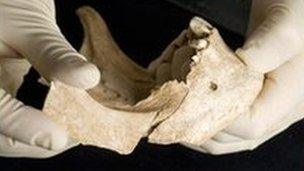Skeletons found in Dorset mass grave 'were mercenaries'
- Published
.jpg)
The bodies were dismembered and entangled
A mass grave in Dorset containing 54 decapitated skeletons was a burial ground for violent Viking mercenaries, according to a Cambridge archaeologist.
The burial site at Ridgeway Hill was discovered in 2009.
Archaeologists found the bodies of 54 men who had all been decapitated and placed in shallow graves with their heads piled up to one side.
Carbon dating and isotype tests revealed the bodies were Scandinavian and dated from the 11th Century.
At this time Vikings were constantly attacking Anglo-Saxons on the English south coast.
Dr Britt Baillie, from the University of Cambridge, said she believed the killings could have taken place during the reign of Aethelred the Unready.
Following a series of Viking attacks he had ordered all Danish men living in England to be killed on 13 November, St Brice's Day in 1002.
The killings which ensued became known as the St Brice's Day massacre.
Murdered methodically
Remains have been found in Oxford and it is thought that massacres also took place in London, Bristol and Gloucester.
However, Dr Baille said in some respects the killings at Ridgeway Hill were unique.
Unlike the frenzied mob attack that took place at Oxford, all the men were murdered methodically and beheaded in an unusual fashion from the front.
The Cambridge academic said she believed the skeletons belonged to a group of Viking killers who modelled themselves on a legendary group of mercenaries.
They were the Jomsvikings, founded by Harald Bluetooth and based at Jomsborg on the Baltic coast.
Military codes
The Jomsvikings became known throughout the medieval world for their strict military codes, which included not showing fear and never running away in the face of the enemy unless completely outnumbered.
This could have led to the men being beheaded from the front, rather than being killed as they tried to escape.

Isotope testing was carried out on the men's teeth
Dr Baillie also found evidence for the men being imitators of Jomsvikings, in their teeth.
One man's teeth had incisions which could suggest that he had filed them himself to demonstrate his bravery.
Both of these features led Dr Baillie to believe that this was a group of mercenaries imitating the Jomsvikings, if not the Jomsvikings themselves.
Aethelred's second wife Queen Emma is known to have recorded a group of Viking killers in England at the time, led by Thorkel the Tall, an alleged Jomsviking.